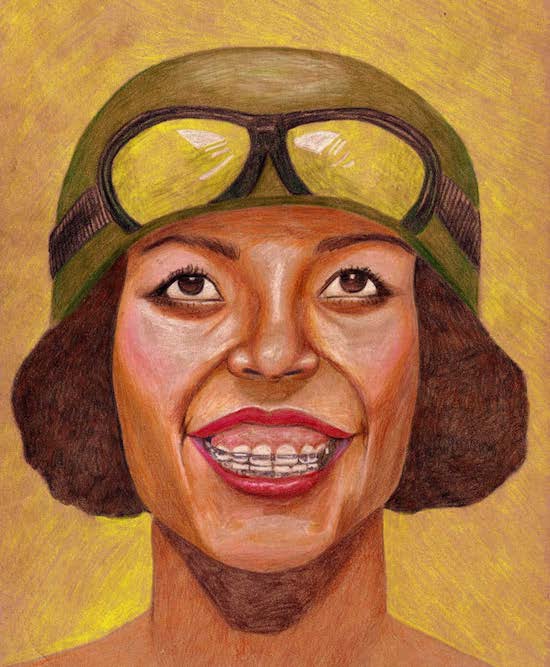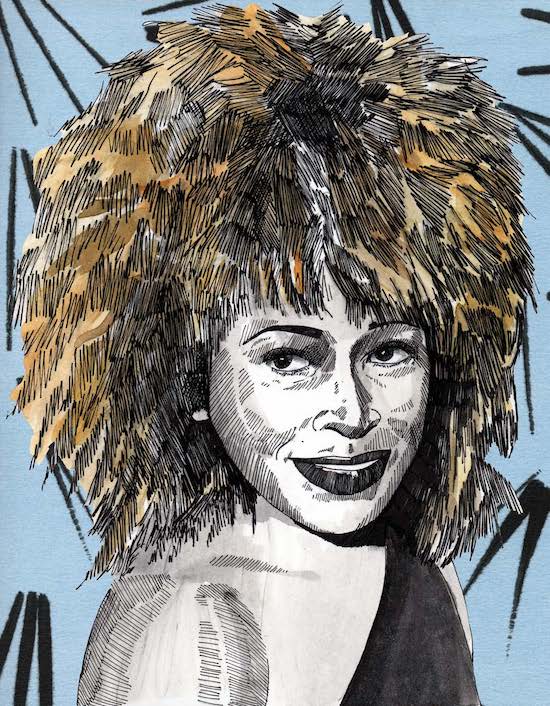Debbie Harry. Credit: Winnie T. Frick
The biggest takeaway from Women Who Rock, a newly-published collection of biographical profiles of 103 influential female musicians mostly from the rock and roll era, is how much these influential women have in common with each other despite coming from different historical eras, circumstances and musical genres. When you read the profiles of musicians like Nina Simone, Tina Turner, Carole King, Debbie Harry, Kate Bush, Janet Jackson, Sleater-Kinney, and M.I.A chronologically, you gradually notice a common thread that runs throughout the book: these are extraordinary women who fought against the rock patriarchy and forged their own trailblazing path for themselves and other aspiring artists. In a way, the stories in Women Who Rock mirror the history of the feminist movement from the second wave on, albeit in a musical context.
This anthology, which was edited by the American music journalist and critic Evelyn McDonnell, is notable for a couple of reasons, and not just because of the broad diversity of the musicians’ styles, racial backgrounds, and sexual orientations covered in the book. It’s the first up-to-date collection of women musician profiles – from Bessie Smith to Alabama Shakes’ Brittany Howard – in over 20 years, and all of them penned by female music writers. The contributors are a mix of veteran journalists and scholars such as Ann Powers, Vivien Goldman, Holly George-Warren, Gillian G. Gaar, and Daphne Brooks, as well as younger and emerging writers including Katherine Turman, Rebecca Haithcoat and Solvej Schou. Several musicians such Peaches and Stephanie Phillips of Big Joanie also contributed pieces. And rather than using photographs, Women Who Rock features portraits rendered by female illustrators.
While Women Who Rock is naturally dominated by the very famous (including Aretha Franklin, Patti Smith, Madonna, Whitney Houston, Amy Winehouse, Beyonce, Taylor Swift and Adele), several under-recognised artists are given their due as well: among them are Ana Tijoux, the French-Chilean hip-hop artist; Carol Kaye, the American session bassist who has appeared in numerous classic 1960s recordings; and June Millington of Fanny, one of the first all-female rock bands. Each profile comes with a playlist of the artist’s selected songs, while the interstitial chapters document the historical eras in which these artists inhabited, from the 1950s to the present day. Featuring some fine and inspired writing, Women Who Rock not only reminds but reclaims women’s importance to the development of popular music. And in the current climate of the #MeToo movement, this ambitious and empowering work is timely.
“Over and over in Women Who Rock, there are stories of women persisting – against all odds,” McDonnell writes in the book’s introduction. “Rape, bad contracts, sexual exploitation, addiction, anorexia, corrupt managers, suicide, domestic violence, prison, murder: These aren’t extreme cases; they are recurring motifs. Women have put up with a lot of shit in order to sing their songs and make their records, to walk in this world and live the lives they choose. Too many of these tales end tragically. But perseverance, hope, family, love, change, stardom, talent, work, and revolution are also themes.”
The driving force behind Women Who Rock, McDonnell is a veteran music writer and critic whose works have appeared in such outlets as The Village Voice, The New York Times, Rolling Stone, and The Guardian. She has also co-edited and written a number books, including Rock She Wrote (with Ann Powers) and Queens Of Noise: The Real Story of the Runaways. A journalism professor at Loyola Marymount University in Los Angeles, McDonnell is also the editor of a new book series, Music Matters, published by University of Texas Press. In this interview with tQ, she talks about the origins of Women Who Rock, the criteria involved in selecting the more than 100 musicians for the book, and the state of women in the music industry today.

Poly Styrene. Credit: Lindsey Bailey
The idea for the book happened about two years ago while you were on a sabbatical, around the time you had a conversation with Becky Koh, the editorial director at book publishing company Black Dog & Leventhal.
Evelyn McDonnell: We were discussing the dearth of a contemporary books on women and popular music. The last big book like this had been Trouble Girls: The Rolling Stone Book of Women in Rock [in 1997]. There have been single-author books that are narrative histories, such as She Bop [by Lucy O’Brien] or She’s a Rebel [by Gillian G. Gaar]. Those books were also from the ‘90s and have been updated. But we didn’t think there’s anything that was a really good overview of a long historic period and bringing us up to today. So were looking at not only Trouble Girls but the original Rolling Stone Illustrated History of Rock & Roll, which we both agreed were great role models. We decided pretty early on the essays that have worked best in those books are the ones that are generally about single artists rather than chapters that try to gather a bunch of different artists together. We really wanted to have profiles. Then we decided that rather than photography, we wanted original illustrations. We also immediately knew we wanted it to be all-female subjects and contributors.
I came up with a list of artists that I thought should be in the book, which was probably about 150. We always knew we couldn’t go above 100. We wanted these to be substantive enough essays that they would be compelling pieces of reading. We also wanted it to be organised chronologically rather than alphabetically, so in that way of being a history as opposed to an encyclopedia. I shared [the initial list] with Becky, and then began soliciting writers and asked if they were interested in contributing, how many things they could write, and ten artists they would like to write about that they think should be in the book.
How did you determine which musicians to feature in the book?
EM: The basic criteria was that they rocked – that they were game-changers in really important ways, whether that was musical innovation [or] that they captured the spirit of an era. And also that they represented a commercial breakthrough for women, or a breakthrough for a certain kind of a woman or a kind of band. And then I wanted a spectrum, and that range included chronological, fairly distributed over at least the years since the 1950s, and then diversity in terms of race, country of origin, and musical genre or style. So we are using ‘rock’ as a verb and a big umbrella term – not a narrow genre – and trying to avoid the traps of what music critics call ‘rockism.’
The book not only features recognisable artists, but some under-the-radar ones like the GTOs and Alice Bag.
EM: That was really important to me, too, because some of the greatest artists go under-recognised, especially some of the greatest women artists. There’s so many hurdles that artists face in terms of their identities, backgrounds and looks. I didn’t want to reinforce that by only choosing artists that people know of or had commercial success. Who really wants to read a book that only has Madonna, Whitney Houston, and Adele in it? If there weren’t people you were discovering, I don’t think you would pick it up. It would be too predictable. I will also say that some of those more obscure choices are the ones that people have reacted to most strongly, certainly on social media. When I post something about Santigold or Poison Ivy from the Cramps, those artists have really strong fan bases. They are really happy to see their artists get that kind of recognition.
You must have agonised over some of the artists who didn’t make the cut in Women Who Rock, including the Slits, whom you acknowledged in the book’s introduction.
EM: I think I was most brutal to the bands that I loved the most, because I really didn’t want this to be about my tastes. I was trying to limit that as much as possible. I felt like I had to choose one or two English punk bands because it was only a five-year period, and I’m covering 100 years. I just had to put Poly Styrene because she was just such a remarkable woman – not that the Slits or the Raincoats weren’t remarkable. And I wrote a book about the Runaways and I didn’t give them a chapter. Those were hard calls.

Tina Turner. Credit: Anne Muntges
How did you find the writers for the book?
EM: Mostly through a Facebook group for women or non-binary music writers that I’ve been part of for many years. I sort of lurked in that group and paid attention to the writers that are posting in there, especially the younger ones, and I just reached out to them. There’s some rock star writers, by which I mean writers that are really well known, like Ann Powers – but also writers who are rock stars, like Peaches or Allison Wolfe. So it’s journalists, scholars, and musicians, which I think gives it a variety.
Segueing from the themes of the book, what is your view on the current state of women in the music industry?
EM: It’s still a really regressive business in so many ways. I did go to a music industry conference over the summer that shall remain nameless. And it was such a weird step back in time. The music industry is still kind of gross, it’s still very sexualised, and that still creates an unfair playing field for talented women. That said, there’s also all kinds of end runs around that available now, thanks to the internet and a lot of women artists and women in the industry and women writers supporting each other. I think there’s a plethora of artists on the underground level that still can find a big enough audience through social media or through small scenes – as well as juggernauts like Beyonce, who uses the word ‘feminism’ in big bright lights. The industry still needs a lot of work, but I think the talent is out there and supported more than ever and getting their voices heard.
The #MeToo movement has made a considerable impact so far on the movie and the media industries. Do you think the music industry will have its day of reckoning as well?
EM: I think it’s happened for a long time. We know Phil Spector’s in jail for his violence towards women. [There’s] Ike Turner and Tina Turner. The Runaways’ story is largely a story of sexual harassment and abuse, and triumphs against that in some ways and not triumphing against that. And Kesha was one of the first celebrities to take a #MeToo stance before it was even a hashtag. We’ve talked about R. Kelly for how many years now? So I think it’s been going on in the music industry. It still goes on in the music industry. We have been talking about it. There’s been a lot of outing of different, maybe lesser-known, musicians and publicists, etc.
You’ve been writing about popular music for a long time, especially in the context of feminist issues. Where did that stem from?
EM: I’ve always identified as a feminist. My mother was a role model and an inspiration for me. She had a difficult life and been abused, and I found that out. So that’s very meaningful to me, the #MeToo movement. When I started out to be a music critic, I just wanted to write about all music, and I still want to write about all music. Honestly, I do feel like I got pointed in a direction that I was happy to write about. But I was also happy to write about Bruce Springsteen! The guys hogged up the discourse about Bruce Springsteen, so I wrote about Patti Smith. So I understand why women artists don’t necessarily want to be identified as women artists, because they don’t want to be in that kind of ghettoization – I’ve felt that in my own career. But I’m happy to be a woman and a feminist.
What would you like people to come away with from reading the book?
EM: I want them to spend days and days listening to the [music of the] artists inside it as they read along, and discover music that changes their lives – just like it changed mine.
Women Who Rock, edited by Evelyn McDonnell, is published by Black Dog & Leventhal



